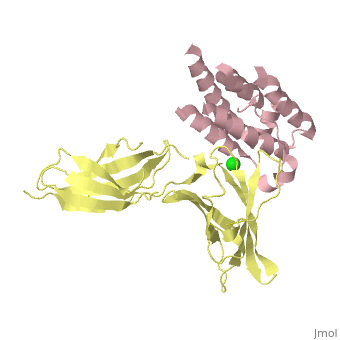3s9d
From Proteopedia
(Difference between revisions)
| Line 10: | Line 10: | ||
== Function == | == Function == | ||
[https://www.uniprot.org/uniprot/IFNA2_HUMAN IFNA2_HUMAN] Produced by macrophages, IFN-alpha have antiviral activities. | [https://www.uniprot.org/uniprot/IFNA2_HUMAN IFNA2_HUMAN] Produced by macrophages, IFN-alpha have antiviral activities. | ||
| + | <div style="background-color:#fffaf0;"> | ||
| + | == Publication Abstract from PubMed == | ||
| + | Type I Interferons (IFNs) are important cytokines for innate immunity against viruses and cancer. Sixteen human type I IFN variants signal through the same cell-surface receptors, IFNAR1 and IFNAR2, yet they can evoke markedly different physiological effects. The crystal structures of two human type I IFN ternary signaling complexes containing IFNalpha2 and IFNomega reveal recognition modes and heterotrimeric architectures that are unique among the cytokine receptor superfamily but conserved between different type I IFNs. Receptor-ligand cross-reactivity is enabled by conserved receptor-ligand "anchor points" interspersed among ligand-specific interactions that "tune" the relative IFN-binding affinities, in an apparent extracellular "ligand proofreading" mechanism that modulates biological activity. Functional differences between IFNs are linked to their respective receptor recognition chemistries, in concert with a ligand-induced conformational change in IFNAR1, that collectively control signal initiation and complex stability, ultimately regulating differential STAT phosphorylation profiles, receptor internalization rates, and downstream gene expression patterns. | ||
| + | |||
| + | Structural linkage between ligand discrimination and receptor activation by type I interferons.,Thomas C, Moraga I, Levin D, Krutzik PO, Podoplelova Y, Trejo A, Lee C, Yarden G, Vleck SE, Glenn JS, Nolan GP, Piehler J, Schreiber G, Garcia KC Cell. 2011 Aug 19;146(4):621-32. PMID:21854986<ref>PMID:21854986</ref> | ||
| + | |||
| + | From MEDLINE®/PubMed®, a database of the U.S. National Library of Medicine.<br> | ||
| + | </div> | ||
| + | <div class="pdbe-citations 3s9d" style="background-color:#fffaf0;"></div> | ||
==See Also== | ==See Also== | ||
| Line 16: | Line 25: | ||
*[[Interferon receptor 3D structures|Interferon receptor 3D structures]] | *[[Interferon receptor 3D structures|Interferon receptor 3D structures]] | ||
*[[Multiple sclerosis|Multiple sclerosis]] | *[[Multiple sclerosis|Multiple sclerosis]] | ||
| + | == References == | ||
| + | <references/> | ||
__TOC__ | __TOC__ | ||
</StructureSection> | </StructureSection> | ||
Current revision
binary complex between IFNa2 and IFNAR2
| |||||||||||

